After a LONG day of bagging on Monday, today went surprisingly easy as reports trickled in from the high bidders on the round 3 fish. As I type this now at 11 PM, all recipients have reported in that the fish arrived alive and in great shape. Several compliments on the packing came in as well (I’m packing these fish per direct instructions from Mark Martin at Blue Zoo, and the packaging design seems to be very effective for such precious cargo).
Last night I moved all the remaining fish out of the grow-out system and into the individual cubes; at some point this week I hope to take the updated photos and determine which fish go in the next round. I’m guessing a round of 5-6 fish. I’ve told some people this already, but I’ll put it out there in the usual spirit of transparency associated with The Lightning Project. My aim is to hold back the best last two fish; these will be the final auction IF it comes to that. Blue Zoo and I have of course stood behind these fish arriving alive, and part of that guarantee has been that if there was a problem with a fish, we would invite the winning bidder to select another fish from the inventory of comparable quality -or- simply refund the money; buyers choice. As we draw to a close, it’s tough to make that same offer, so any losses seen with this next group will need to have a fish that I feel is as good, if not superior to, any of the fish in the round….thus, I will be saving the best for last. Presuming all fish from the next round make it well, it will leave 2 fish left for a last final round, 1 White Stripe and 1 Lightning, to which I will not have any replacements to offer.
Once those auctions are done, it will not be until winter/spring of 2014 before we can even hope to see more lightnings ready for market. Spawn #12 is going well so far, eating me out rotifers, and as of today, 9-24-2013, Spawn #13 was thrown down!
- About The Lightning Project
- Inventory of F1 PNG Lightning and White Stripe Maroon Clownfish
- F1 PNG Lightning Maroon Clownfish, BZLM1
- F1 PNG Lightning Maroon Clownfish, BZLM2
- F1 PNG Lightning Maroon Clownfish, FW1
- F1 PNG Lightning Maroon Clownfish, LM10
- F1 PNG Lightning Maroon Clownfish, LM11
- F1 PNG Lightning Maroon Clownfish, LM12
- F1 PNG Lightning Maroon Clownfish, LM13
- F1 PNG Lightning Maroon Clownfish, LM14
- F1 PNG Lightning Maroon Clownfish, LM15
- F1 PNG Lightning Maroon Clownfish, LM16
- F1 PNG Lightning Maroon Clownfish, LM17
- F1 PNG Lightning Maroon Clownfish, LM18
- F1 PNG Lightning Maroon Clownfish, LM19
- F1 PNG Lightning Maroon Clownfish, LM20
- F1 PNG Lightning Maroon Clownfish, LM3
- F1 PNG Lightning Maroon Clownfish, LM4
- F1 PNG Lightning Maroon Clownfish, LM5
- F1 PNG Lightning Maroon Clownfish, LM6
- F1 PNG Lightning Maroon Clownfish, LM7
- F1 PNG Lightning Maroon Clownfish, LM8
- F1 PNG Lightning Maroon Clownfish, LM9
- F1 PNG Lightning Maroon Clownfish, MD1
- F1 PNG Lightning Maroon Clownfish, MWP3
- F1 PNG Lightning Maroon Clownfish, WS17
- F1 PNG Lightning Maroon, EC1
- F1 PNG Lightning Maroon, GL1
- F1 PNG White Stripe Maroon Clownfish, BZWS1
- F1 PNG White Stripe Maroon Clownfish, BZWS2
- F1 PNG White Stripe Maroon Clownfish, BZWS3
- F1 PNG White Stripe Maroon Clownfish, WS10
- F1 PNG White Stripe Maroon Clownfish, WS11
- F1 PNG White Stripe Maroon Clownfish, WS12
- F1 PNG White Stripe Maroon Clownfish, WS13
- F1 PNG White Stripe Maroon Clownfish, WS14
- F1 PNG White Stripe Maroon Clownfish, WS15
- F1 PNG White Stripe Maroon Clownfish, WS16
- F1 PNG White Stripe Maroon Clownfish, WS4
- F1 PNG White Stripe Maroon Clownfish, WS5
- F1 PNG White Stripe Maroon Clownfish, WS6
- F1 PNG White Stripe Maroon Clownfish, WS7
- F1 PNG White Stripe Maroon Clownfish, WS8
- F1 PNG White Stripe Maroon Clownfish, WS9
- F1 PNG White Stripe Maroon, EC2
- F1 PNG White Stripe Maroon, FW2
- F1 PNG White Stripe Maroon, GL2
- F1 PNG White Stripe Maroon, MD2
- Lightning Breeding Directive
- Lightning Maroon Clownfish Links
- Home
- About The Lightning Project
- Inventory of F1 PNG Lightning and White Stripe Maroon Clownfish
- F1 PNG Lightning Maroon Clownfish, BZLM1
- F1 PNG Lightning Maroon Clownfish, BZLM2
- F1 PNG Lightning Maroon Clownfish, FW1
- F1 PNG Lightning Maroon Clownfish, LM10
- F1 PNG Lightning Maroon Clownfish, LM11
- F1 PNG Lightning Maroon Clownfish, LM12
- F1 PNG Lightning Maroon Clownfish, LM13
- F1 PNG Lightning Maroon Clownfish, LM14
- F1 PNG Lightning Maroon Clownfish, LM15
- F1 PNG Lightning Maroon Clownfish, LM16
- F1 PNG Lightning Maroon Clownfish, LM17
- F1 PNG Lightning Maroon Clownfish, LM18
- F1 PNG Lightning Maroon Clownfish, LM19
- F1 PNG Lightning Maroon Clownfish, LM20
- F1 PNG Lightning Maroon Clownfish, LM3
- F1 PNG Lightning Maroon Clownfish, LM4
- F1 PNG Lightning Maroon Clownfish, LM5
- F1 PNG Lightning Maroon Clownfish, LM6
- F1 PNG Lightning Maroon Clownfish, LM7
- F1 PNG Lightning Maroon Clownfish, LM8
- F1 PNG Lightning Maroon Clownfish, LM9
- F1 PNG Lightning Maroon Clownfish, MD1
- F1 PNG Lightning Maroon Clownfish, MWP3
- F1 PNG Lightning Maroon Clownfish, WS17
- F1 PNG Lightning Maroon, EC1
- F1 PNG Lightning Maroon, GL1
- F1 PNG White Stripe Maroon Clownfish, BZWS1
- F1 PNG White Stripe Maroon Clownfish, BZWS2
- F1 PNG White Stripe Maroon Clownfish, BZWS3
- F1 PNG White Stripe Maroon Clownfish, WS10
- F1 PNG White Stripe Maroon Clownfish, WS11
- F1 PNG White Stripe Maroon Clownfish, WS12
- F1 PNG White Stripe Maroon Clownfish, WS13
- F1 PNG White Stripe Maroon Clownfish, WS14
- F1 PNG White Stripe Maroon Clownfish, WS15
- F1 PNG White Stripe Maroon Clownfish, WS16
- F1 PNG White Stripe Maroon Clownfish, WS4
- F1 PNG White Stripe Maroon Clownfish, WS5
- F1 PNG White Stripe Maroon Clownfish, WS6
- F1 PNG White Stripe Maroon Clownfish, WS7
- F1 PNG White Stripe Maroon Clownfish, WS8
- F1 PNG White Stripe Maroon Clownfish, WS9
- F1 PNG White Stripe Maroon, EC2
- F1 PNG White Stripe Maroon, FW2
- F1 PNG White Stripe Maroon, GL2
- F1 PNG White Stripe Maroon, MD2
- Lightning Breeding Directive
- Lightning Maroon Clownfish Links
So, a total hatch. Last night, before lights out, there was ONE larvae swimming around and a scattering of dead eggs on the bottom. I checked at 7 AM (up to get the kids out the door every day now) and shazam – a full hatch. There was less than 20 eggs on the tile, and the tank is just swarming with them. Mike Doty brought over some rotifers last night (somehow I managed to simultaneously crash all my cultures) and some RotiGreen Omega + Rotifers went into the tank.
There are hundreds of larvae in the tank. We’ll see how it goes from here. I suspect I will have to siphon the bottom today.
On a related note, some (or all) of the fish won in Round 3 of the Blue Zoo Aquatics Lightning Maroon Clownfish auctions on eBay should be shipping today! Thanks to everyone who bid!
Despite all the crazy effort last night to prep for a hatch on spawn #12, it’s now 10:20 AM and nothing has hatched. We are definitely past 144 hours post spawn…based on hatch times from prior clutches they should have hatched, but the 6+ day incubation time always seems short. So hopefully I didn’t kill the eggs with the H202 treatment; there are no eggs on the ground, and nothing hatched, so hopefully it’s just another day and they’ll hatch tonight. We shall see…
So this evening I pulled spawn #12 for hatching, but I’m changing things up. I keep trying the same old thing and get the same old crappy results. So…
#1. I disinfected the spawn for 15 minutes with H202. In a nutshell, I pulled the tank water and the tile, placed them in a large specimen up which holds around 0.5 (half) a gallon of water. I introduced 8.5 ML of Hydrogen Peroxide, added an airstone, and let it sit. After that, I moved the airstone and tile into another specimen cup of the same size containing tank water, but no H202. This was the rinse phase. (Dr. Matthew L. Wittenrich suggests a range of 1 to 5 ML per L, H202 to saltwater, as a treatment in his 2007 book The Complete Illustrated Breeder’s Guide to Marine Aquarium Fishes).
#2. I’m not using a BRT – Black round tubs have many benefits, but they suck in one aspect – you can only observe the contents from above (unless you install a plexiglass window). For this rearing attempt, I tore down one of my old 10 gallon tanks that had been holding freshwater Angelfish fry. The tank in question is painted black on all sides, including the bottom, save one end pane. I scrubbed it, rinsed it, filled it with 5 gallons of water from the broodstock tank and roughly 3 gallons of clean new saltwater from the mixing bucket. This will be my hatching tank this time. Glass tanks like this work fine for clownfish…so screw it, I’m going to SEE what’s going on this time.
#3. I’m using an ammonia alert badge – yes, these are great tools, but they’re designed to be viewed through glass. Great for a 10 gallon tank – bad for a “BRT”. To be honest, even when I’ve used one I’ve never had a problem, but once I started using BRTs I stopped using Seachem Ammonia Alert Badges because they just don’t work. Well..might as well fire it back up.
#4. I tested the broodstock water. I rarely if ever bother with water tests these days…there is seldom any reason to check as the water invariably is always “good”. Still, I might as well be a good aquarist and check things. Currently the Lightning Maroon and her mate were in 8.4 pH, 0 ppm nitrate, and 1.023. The larval tank will wind up being very similar no doubt, maybe 1.0235 for SG (the water in the mixing bucket was around 1.024 on the refractometer).
I placed the tile at the far end of the tank, away from the unpainted end. I left on some room lights; this should allow light to attract the larvae to the front of the tank, away from the heavier air flow. There’s not much else to say about this setup at the moment – this is more akin to my “classic” clownfish rearing of days gone by, and is similar to what many folks still do today for hatching and early rearing.
On the other front – 3 Lightning Maroon offspring are left up for auction, the last being a LM12 whose auction ends Monday morning. I love how Mark @ Blue Zoo Aquatics has hidden bidder identities. I know who a few of the bidders are now from past auctions, but most are still a mystery to me. In any case, I have to say / ask this one thing – are you all having fun?! I know, I know, auctions are thrilling and heartbreaking. Still, I’m an addict myself (I regularly bid, but rarely win, auctions on AquaBid.com). If I was in your shoes, I have to say there must be a great feeling being the one who got to bid $5 for a Lightning Maroon Clownfish, when the auction started. Even if you didn’t win, you at least played a part and got to participate. As most of you have probably followed over the years, I always felt this was “everyone’s” project, and so too, placing these fish up for bid on the open market meant that everyone had a fair and equal shot at getting them.
After round 3, there are at most, 10 fish left to find new homes and THAT WILL BE IT until I manage to rear more. I should mention that the single sole survivor from spawn #10 was moved into a different BRT to live with a slightly older clutch of Sumatran Fire Clowns (Amphiprion ephippium “Sumatra” F1). I was wasting a lot of food feeding a 16 gallon BRT to try to keep only 1 clownfish alive; better to put it in with the 100 or so Fire Clowns rather than overfeed an empty tank on the larviculture system. So far so good, I got to see it swimming around today, so it wasn’t killed, and should grow up alongside it’s cousins without issues.
One last note – it’s a short story. As of last week, I officially had 4 Lightning Maroons and 2 White Stripe siblings held back. The two white stripes are currently in separate breeder nets while I work on size differentiation, and two of the Lighting Maroons are already well documented here. The remaining two were holdbacks I wasn’t sure what I would do with; I still wanted to get one more pair out there to a fellow aquarist, but the person I have in mind isn’t able to take them at the moment. So they’ve just sat here.
Well, I brought them upstairs to free up the cubes for segregation and one has lived in the Ecoxotic 25 gallon cube, while the other was in a breeder net hanging in the tank. In the middle of the week, I let the smaller one in the breeder net out while I cleaned the netting, and afterwards, seeing them in separate sides of the tank, I just left it out for a couple hours. Well…a couple hours was a couple too long; I found the smaller fish beaten, but alive. I put it back in the breeder net, and a few hours later it was dead. That’s all it took.
So please, be very careful trying to pair these fish up. While I personally feel that the Lightning Maroons seem to be rather “timid” in general, they still are quite murderous towards each other.
New Holdback Headcount =5 (unless I take a fish out of “inventory”).
Blue Zoo Aquatics has listed the next 8 offspring from the Lightning Maroon Clownfish, dubbed the “Amazing 8”. The auction is live on eBay at this time – you can view all the auctions quickly via Blue Zoo Aquatics’ eBay items listing.
The first auction started Saturday night, 9/14/2013, with LM7. As of this evening, 7 of the 8 are up, with the last fish, LM12, due to start the morning of 9/18/2013 (just a few hours from now).
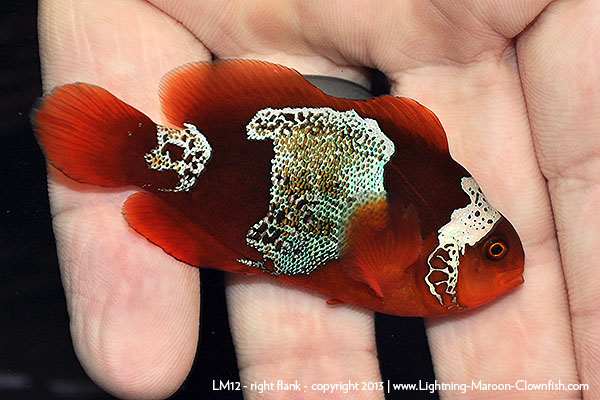
LM12 – the last fish to be listed for the Round 3 Auctions, listing the morning of 9/18/13
Here’s a snapshot of the auctions this very early morning at around 3 AM central time:
LM7 – currently $660.00
WS9 – currently $102.50
WS15 – currently $100.00
LM3 – currently $660.00
WS6 – currently $202.50
WS16 – currently $5.50
WS14 – currently $0.99!
LM12 -to be listed soon…
The other interesting part I have to mention is that this group will remove a large portion of the remaining offspring I’ll have available to sell. 10 fish in the inventory remain, although I have two more Lightning holdbacks I could opt to part with or might use for other purposes, and if all goes well the one sole survivor of Spawn #10, a baby lightning, could play a future role here too.
Fish that will likely be in some future auctions include WS4, WS7, LM6. LM9, WS11, LM11, WS13, LM13, LM14, LM17.
I should point out that if you want a white stripe offspring, there won’t be many chances left and you might want to secure your fish this time. I may need to select one or two of the remaining four for my own breeding purposes; either way after round #3, there simply wont’ be much left in the way of White Stripe siblings (I still believe that the most promising pairing to produce more Lightning Maroons will be a Lightning crossed with it’s White Stripe sibling, which I think will yield 50/50 results just like their parents).
It’s delightful to see that the Lightning Maroon pair has finally settled into a spawning routine. No sooner had I botched spawn #11, and they go put down spawn #12. On an interesting side note, I discovered what apparently happened with Spawn #10 – about a week after the larvae had all vanished, I took a look at the black round tub that was sitting there, now empty. It was absolutely OVERRUN with hyrdoid medusas. I’m not sure how hydroids got into the mix; the other BRT, which contains a single now post-settlement juvenile Lightning Maroon baby (so cute) has not had any hydroid issues crop up. I’ll have to drain and sterilize the BRTs before using them for Spawn #12.
Spawn #12 was laid on September 15th, 2013. This means, based on our current “144 hours” to hatch rate, means I need to pull the eggs as early as this coming Saturday night, September 21st. This is spawn number #12, photographed 24 hours after being laid.
Walked into the fishroom Thursday night and saw something on the floor that didn’t belong there…

Upon closer inspection…
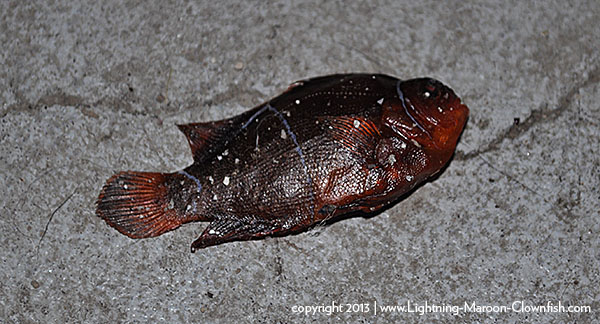
It would appear that White Stripe #12, aka. WS12, had some suicidal tendencies.
Now, before I get a bunch of nasty or snide comments about how I should be using covers on my tanks, you probably need to look at this:
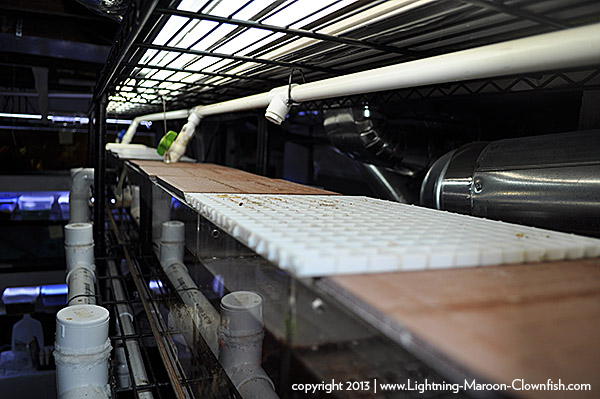
This is how I keep the vast majority of my Lightning Maroons covered up. With heavy ceramic tile no less. WS12 is, to the best of my recollection, the 2nd Lightning Maroon offspring to have jumped in the entirety of the project. And no, I didn’t do this after the fact…
Please, if you’re keeping any of my fish – no open top tanks. It’s just too risky. Don’t think clownfish can’t / won’t jump.
FWIW…
So last night I was simply too tired by the time egg pulling came around; I took a calculated risk and left the eggs with the parents overnight. I left a few extra lights on in the fishroom.
Come morning, most of the eggs were still there. Great I thought…I’ll pull them tonight and I’ll get a BIG hatch instead of this paltry premature hatch I seem to get with the rest of the eggs dying.
10:30 PM, I head down to the fishroom…eggs are gone. Spawn #11 is done.
Carl W. Phillips Jr. mentioned something on the Lightning Maroon Clownfish Facebook Page early today. “I’m not an expert but maybe the eggs weren’t viable???” And the question I find myself asking this evening – did the eggs hatch during the middle of the day, or were the dead and the parents ate them?
This jogged my memory on something I had been thinking when I saw the mass mortality of eggs on the 2nd day holding the eggs for hatching with spawn #10. Maybe the reason I’m not getting many eggs to hatch is that there is something wrong with the eggs in the first place.
Going back to Joyce Wilkerson’s bible, Clownfishes, I recall that egg hatching failure was attributed to diet. Specifically, too much chiton in the diet, presumably from crustacean food sources. I don’t think I have excessive chiton by any stretch; it could be something entirely different.
My options – larval snagger (to catch larvae hatching by the parents…assuming the eggs are viable) – disinfection (in case this mortality is being caused by some external problem) – diet alterations (I have some ideas on how to change).
Hopefully the now routine spawns with this pair continue so I can FINALLY get down to the bottom of things.
It’s been a busy couple weeks around MACNA and I wasn’t even THERE this time! I have to circle back to the last update which left us with Spawn #9’s babies disappearing, and the laying down of Spawn #10 on 8-26-2013.
Well…I did not pulled Spawn #10 as planned on the night of September 2nd – I think folks are right in terms of me getting confused counting nights vs. days; if counting “nights”, 8-26 was the first night, meaning that the 7th night would be 9-1-2013. The pair was going nuts tending the eggs that evening, which tends to indicate a pending hatch. So the eggs were pulled on the evening of 9-1-2013, only 144 hours post spawn.
This worked somewhat well – the next morning there was a hatch of possibly as many as 100 offspring.
With the bulk of the eggs NOT hatching this night, I opted to move the tile to another spare black round tub so that the next night’s hatch would be separated and any dying / decaying eggs would not pollute the first group.
The next night, there was a very small hatch, and most of the eggs were found dead. I transferred all the larvae I could find (< 10) in with their siblings from the night prior.
Meanwhile, an incident with the 2012 group of Lightning Maroons the week prior resulted in the demise of LM10 on September 4th.
It’s hard to say exactly what occurred, but several days prior when observing the remaining ‘communally’ grouped offspring, I noticed that both pectoral fins on LM10 had been chewed back – this is a common fin damage the fish inflict upon each other while sparring, and all times prior, segregating the fish has resulted in a quick recovery. For whatever reason, LM10 did not recover, but instead spiralled downhill, going of feed, breathing heavily and ultimately dying. It is my guess that a systemic bacterial infection took hold and made quick work of this fish, but ultimately I’ll never know for sure.
Meanwhile, with the last fish shipping from the Round 2 auctions, it opened up enough holding space to prevent any future murders or problems with aggression. As of 9-4, all the remaining siblings were segregated, whether into the holding cubes or breeder nets placed in the growout system.
This was pretty much the last look I had ad what had seemed like a promising run for Spawn #10. The next day, on 9-5, the offspring crashed and vanished, and were gone by Friday, the 6th. Water tests revealed nothing conclusive, no elevated ammonia or low pH to blame. Ironically, the the tub that had contained the 2nd night’s hatch from spawn 10, 2 stragglers evaded my attempts to combine them with their siblings, and so tonight, 9-10, there is at least one viable offspring remaining from spawn #10. ONE.
It would seem that the Lightning Maroon pair has finally hit its stride in the sex department, so at least my seemingly never-ending blunders are met with the chance to do better the next time! On 9-4-2013, the pair put down spawn #11.
It’s my plan to do things differently this time. I’m going to skip the black round tub (BRT) in favor of the “traditional” 10 gallon aquarium. It is my thought that at least part of my difficulties lie in the lack of access to viewing the offspring from anyplace other than above. This makes it difficult to gauge whether larvae are standing on the bottom, or in midwater, while not visible from above.
The big question tonight – being 9-10, now roughly 144 hours post spawn, do I pull it? I should get some larvae if I pull the nest, but it again may be premature…
One other note – one new fish added to the “inventory” – LM17 is the only offspring to be around so far from 2013. You can read all about him here.
I’ve invited all winning bidders from the Blue Zoo Aquatics Lightning Maroon Clownfish auctions to share updates here on the Lightning Project’s website to allow me and others to keep track of the offspring after thye’ve left my care.
Susan Ingold of S & R Clownfish sent an update and a few images of WS8 and WS10 on September 7th, and I wanted to share her update with you on this future F1 pairing of the Lightning Maroon’s White Stripe offspring. Here’s the update from Sue:
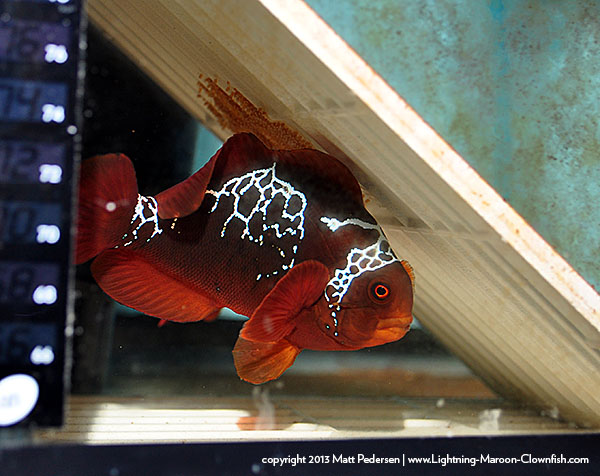


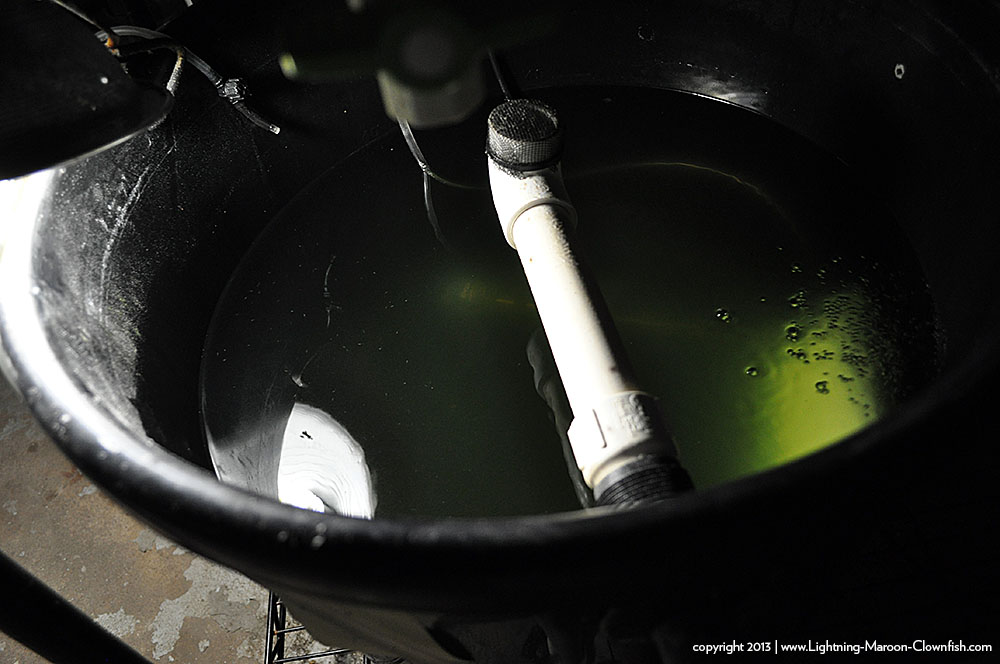
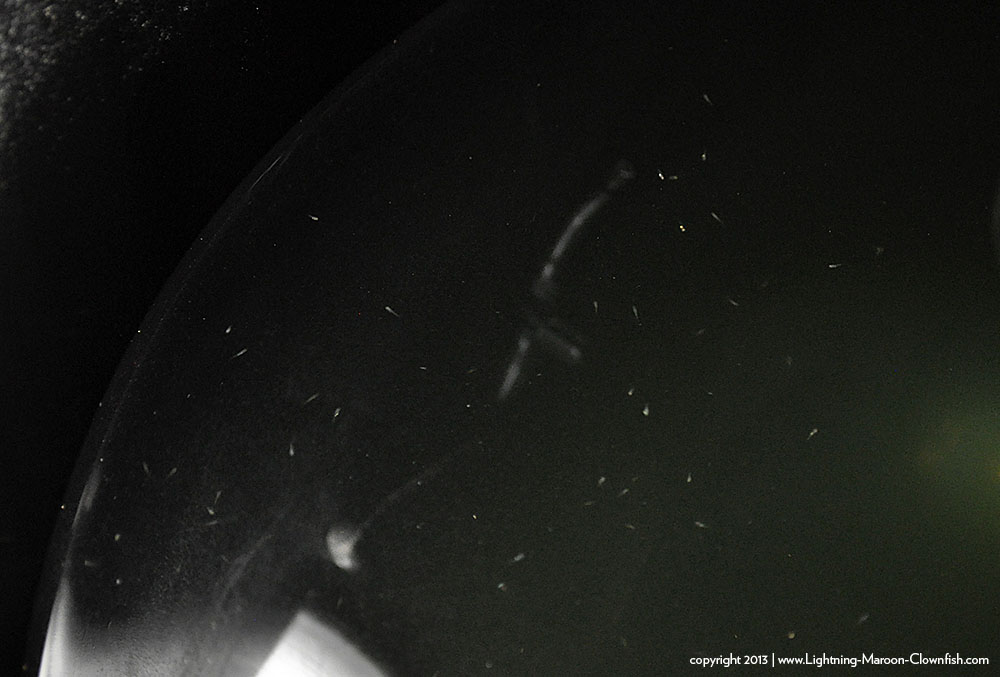
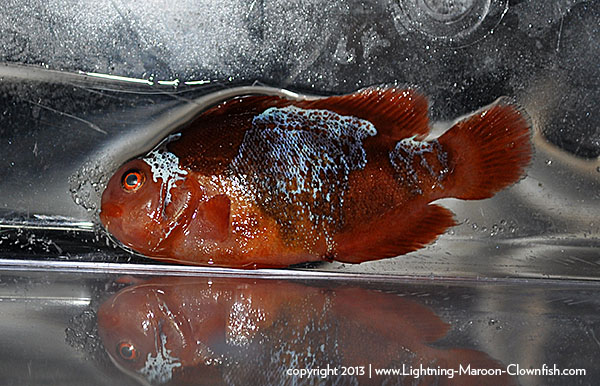
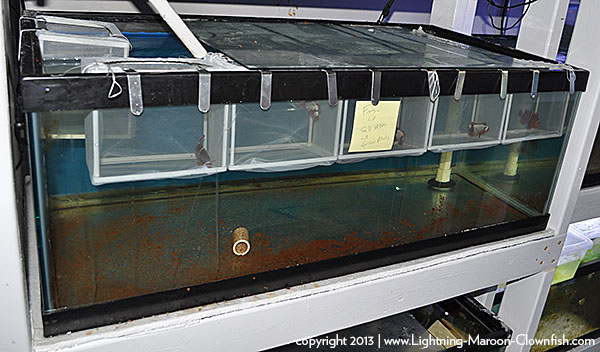
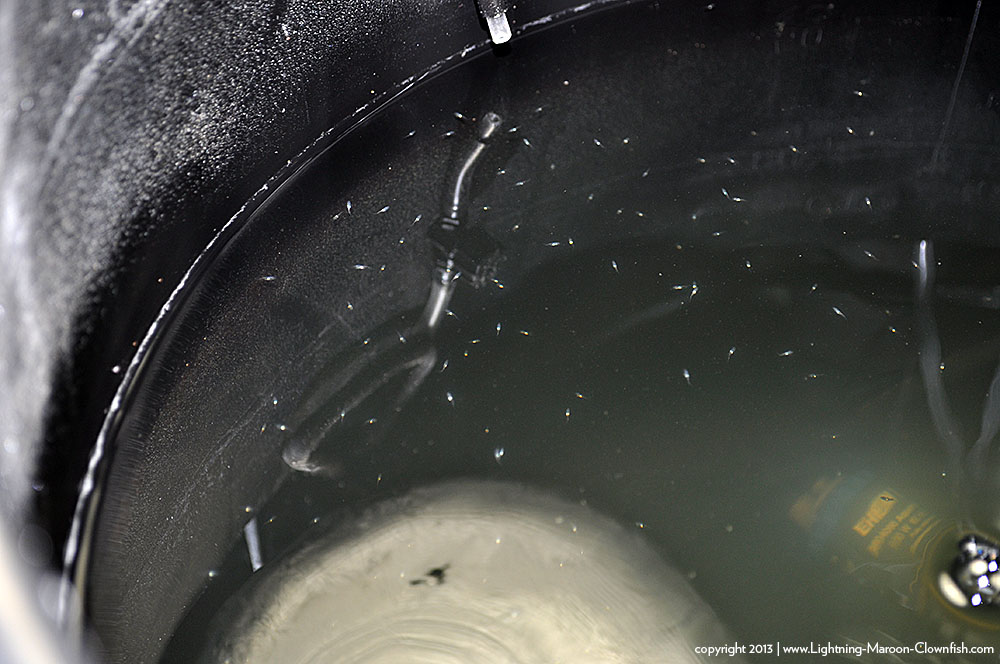
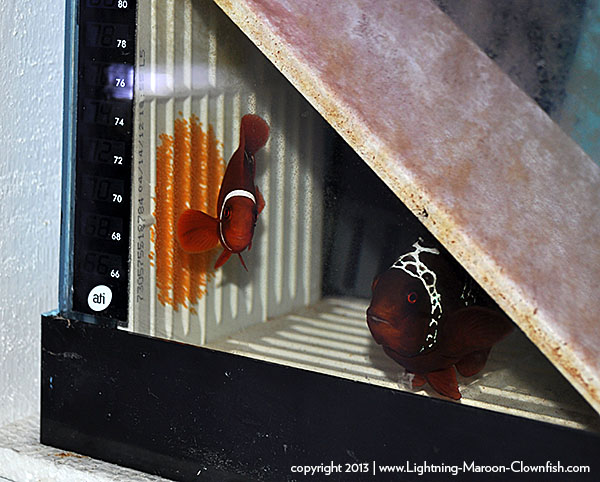
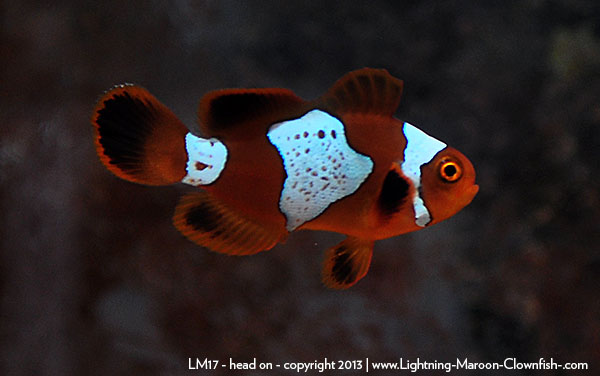
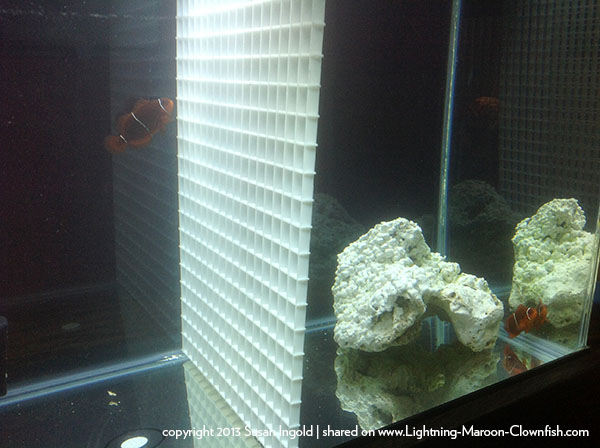
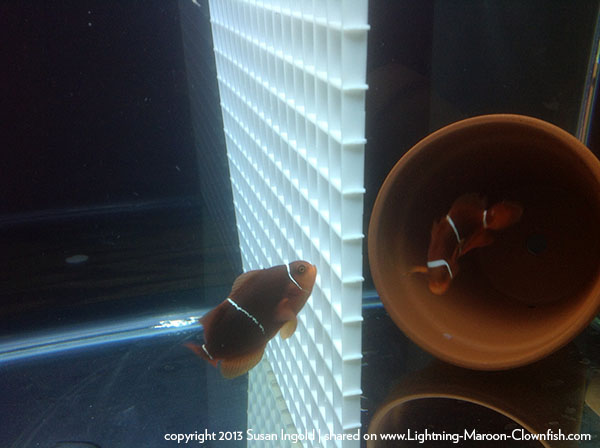
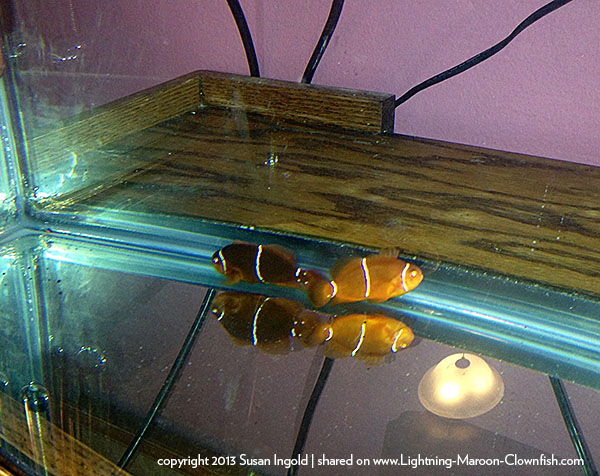

Recent Comments